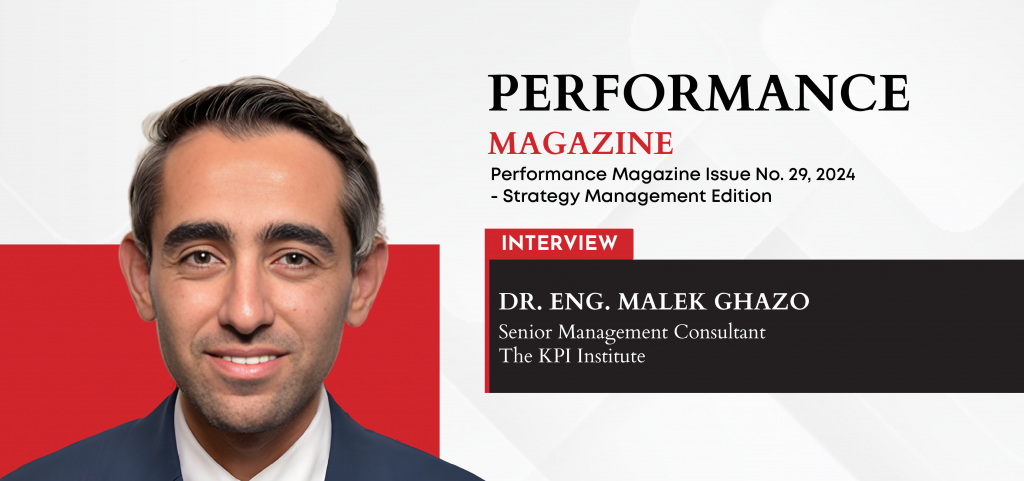Embracing Agile Strategies for Organizational Success

Amidst the dynamic shifts in today’s organizational landscape, the traditional notion of a one-size-fits-all strategy is being challenged. To align with diverse factors such as culture, structure, goals, and external influences, a reevaluation of the traditional or accustomed strategy becomes essential. In this interview, Dr. Eng. Malek Mohammed Ghazo shared different ways that organizations can align their strategy with the organization’s specific needs, aiming for resilience, adaptability, and sustained success.
Aligning strategy with culture is akin to solving a jigsaw puzzle due to the involvement of different perspectives and factors. As a management consultant, what advice would you offer organizations and professionals when fitting these intricate pieces together?
To align strategy with culture, cultivate leadership buy-in at all levels. Ensure that leaders embody and advocate the organization’s values and strategic vision. Encourage open dialogue, recognize diverse perspectives, and foster an environment of trust and collaboration. This holistic approach ensures that culture and strategy are interwoven, driving unified progress.
What cultural nuances do you think will shape the strategic landscape in 2024?
In 2024, cultural nuances like inclusivity, agility, and continuous learning will shape the strategic landscape. Organizations that value diversity and adaptability to change and are committed to upskilling will be able to effectively navigate the dynamic environment. Ethical considerations and sustainability will also play pivotal roles, reflecting a broader focus on societal values in strategic priorities.
Read More >> Why a Plan Is NOT a Strategy
Trends
In light of global economic shifts and geopolitical uncertainties, how can organizations create resilient strategies that can withstand external disruptions?
Organizations should integrate agility into their DNA, leveraging excellence frameworks and ecosystem mapping to anticipate changes. Embracing adaptive planning and fostering a culture of innovation ensures resilience. Investing in robust risk management and nurturing strategic partnerships can buffer against uncertainties, enabling a proactive stance in volatile environments.
What do you see as the most promising ways artificial intelligence (AI) can further impact corporate strategy, and what steps should companies take to remain at the forefront of AI-driven strategic advancements?
AI’s potential lies in predictive analytics and decision-making enhancement. Companies should invest in both talent and infrastructure to integrate AI insights into strategic planning. Staying ahead requires a culture of continuous learning and ethical AI use, ensuring that strategies are data-informed, agile, and attuned to evolving market dynamics.
Does your organization use strategic foresight to enhance future readiness? If not, please detail the organization’s approach to planning in the short, medium, and long term.
Our organization prioritizes strategic foresight, aligning with practices like Dubai’s 50-year vision. We employ future foresight planning to balance immediate adaptability with medium-term trend analysis and long-term vision creation. This approach ensures sustained relevance, innovation, and resilience in an ever-evolving global landscape.
Read More >> Optimizing Employee Performance: A Case Study on Effective Strategy Execution
Strategy and Performance Management Practices
Do you see any application of AI to facilitate strategic planning or performance measurement? Is your organization using any such tool, possibly in certain areas of the organization?
AI significantly enhances strategic planning and performance measurement through predictive analytics and data-driven insights. Our organization employs AI tools, particularly in market analysis and operational efficiency, leveraging AI’s capability to forecast trends and optimize decision-making processes with Future Foresight (FF) tools.
How are strategic objectives defined in your organization, including the research process, involved stakeholders, and other pertinent details?
Our organization defines strategic objectives comprehensively, integrating stakeholder insights via a robust mapping system. By employing the Balanced Scorecard (BSC) approach, we ensure that objectives are well-rounded—aligning financial, customer, internal process, and learning perspectives— to foster a holistic and forward-thinking strategic framework.
How do you balance long-term planning and short-term priorities?
Balancing long-term planning with short-term priorities involves a dynamic BSC framework approach. We continuously align short-term actions with our long-term vision, ensuring that immediate objectives support overarching goals. Regular stakeholder engagement and performance reviews allow agile adaptation, maintaining equilibrium between immediate results and strategic future aspirations.
In your experience, what is the most important tool for managing strategy, and why?
In my experience, an agile resource allocation system is the most crucial tool for managing strategy. It allows swift adaptation to market changes and enables resources to be optimally distributed to high-impact areas. This agility fosters resilience, maintains a competitive edge, and ensures that strategic objectives are met efficiently.
How do you communicate strategy to different stakeholders within the organization to ensure a high level of awareness of priorities for both frontline employees and management positions?
Effective communication of strategy involves clear and consistent messaging tailored to different stakeholder groups. Utilizing a variety of channels, we ensure that frontline employees and management understand priorities through regular updates, workshops, and dashboards. This strategy fosters alignment, engagement, and a shared commitment to organizational goals across all levels.
What key elements is your organization using to ensure effective strategy execution?
Our organization facilitates effective strategy execution through an agile project management framework, a centralized project management office (PMO), data and benchmarking offices, and dedicated process and governance teams. This integrated approach streamlines execution, ensures data-driven decision-making, and maintains alignment with strategic objectives, driving consistent and impactful results.
What approaches or methodologies have you found effective in fostering cross-functional collaboration and ensuring that all departments work cohesively towards strategic goals?
Leveraging automated tools and platforms has proven effective in fostering cross-functional collaboration. These tools facilitate seamless communication, project tracking, and data sharing across departments, advancing alignment and synchronized efforts toward strategic goals. This tech-enabled approach enhances transparency and accountability to drive cohesive, organization-wide progress.
What critical skills and competencies should professionals develop to excel in strategic management?
Professionals should cultivate agility-related skills such as adaptive thinking, strategic foresight, and resilience. Competencies in data-driven decision-making, effective communication, and collaborative leadership are also essential. These skills enable professionals to navigate complex environments, drive innovation, and lead teams toward achieving strategic objectives.
**********
Editor’s Note: This article was originally published in Performance Magazine Issue No. 29, 2024 – Strategy Edition. The practitioner’s bio has been updated to reflect his current achievements and credentials.
About the Practitioner: Dr. Eng. Malek Ghazo has over 14 years of experience in management consulting. He has trained more than 1,500 people and spearheaded organizational excellence and sustainability projects across the UK, Jordan, UAE, KSA, and Qatar. Ghazo holds a Master of Science in Engineering and Management and a Ph.D. in Circular Economy, Sustainability, and Excellence.

